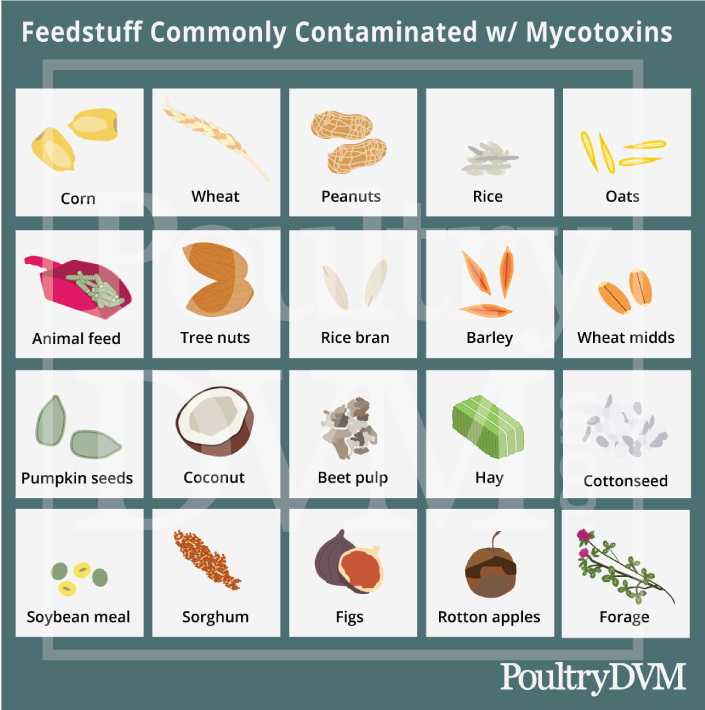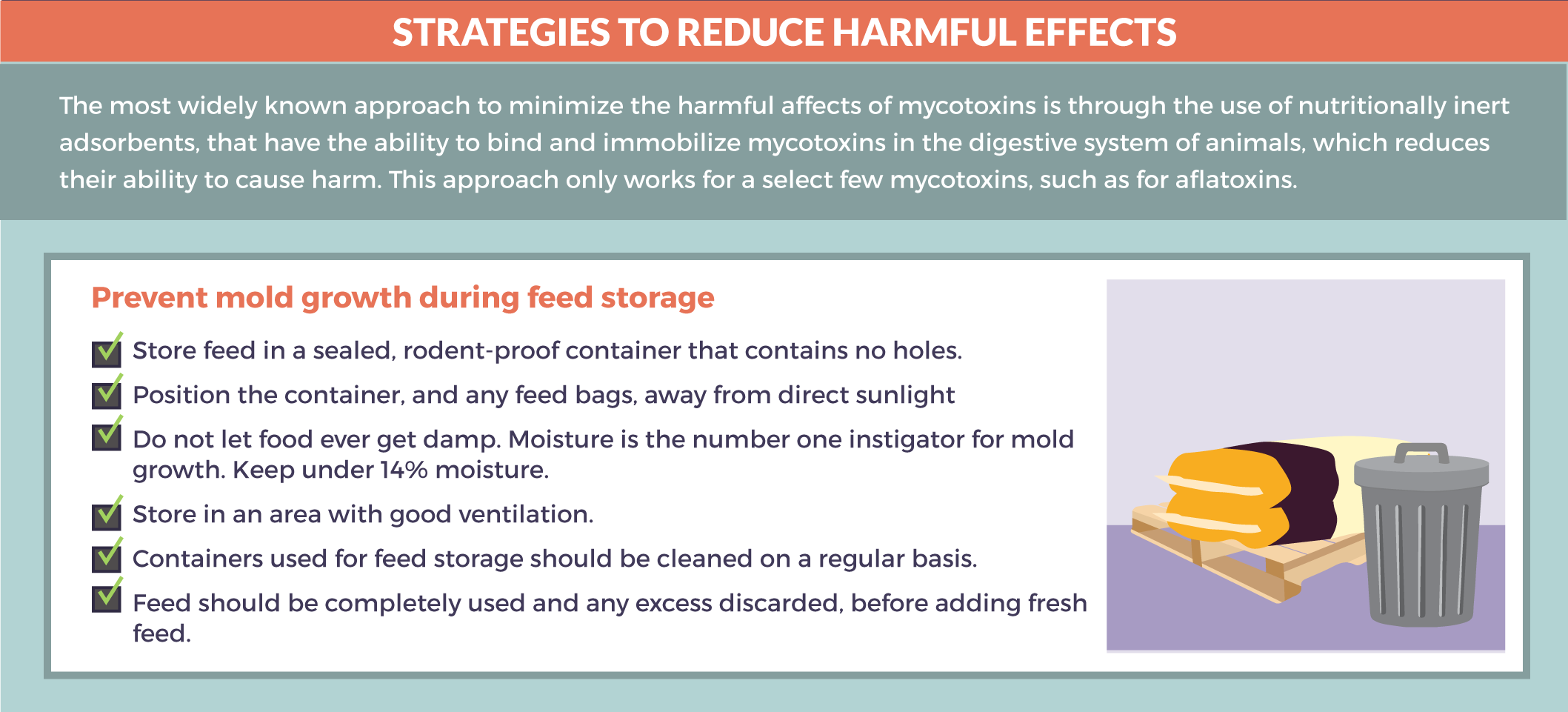Veterinary advice should be sought from your local veterinarian before applying any treatment or vaccine. Not sure who to use? Look up veterinarians who specialize in poultry using our directory listing. Find me a Vet
Other Names: Avian Mycotoxicosis

| Mycotoxin | Exposure Effects | Regulatory limits for animal feed |
|---|---|---|
| Aflatoxins (AF) | Causes liver damage, tumors, gastrointestinal dysfunction, reduced productivity, birth defects, and suppressed immune system. | EU: <20 ppb FDA: For starter and grower feeds, corn, and peanut products intended for poultry feed, excluding cottonseed meal: <20 ppb Laying hen feed, corn and peanut products intended for mature poultry: <100 ppb Cottonseed meal intended for all poultry: <300 ppb |
| Citrinin | Causes kidney damage, watery fecal droppings, reduced weight gain, anemia, hyperkalemia, metabolic acidosis, and reduced blood pH | EU/FDA: No restrictions set |
| Cyclopiazonic acid | Poor weight gain and feed conversion, reproductive tract impairment | EU/FDA: No restrictions set |
| Ergotamine | Tissue necrosis and neurological signs | EU/FDA: No restrictions set |
| Deoxynivalenol (DON) | Damages the epithelial intestinal barrier of the chicken's gastrointestinal tract, inhibits protein synthesis, and predisposes them to developing necrotic enteritis | EU: < 5 ppm FDA (only advisory level, does not enforce): < 10 ppm for grain and grain by-products and < 5 ppm for complete feeds. |
| Fumonisins | Damages the intestinal barrier of the GI system, decreases nutrient absorption, predisposes chickens to developing necrotic enteritis | EU: < 20 mg/kg FDA: < 50 mg/kg |
| Fusarochromanone | Tibial dyschondroplasia | EU/FDA: No restrictions set |
| Moniliformin | Acute death | EU/FDA: No restrictions set |
| Ochratoxin A (OTA) | Weight loss, granular degeneration in the epithelium and mononuclear cell infiltration and activation of capillary endothelium in the kidney and liver; degenerative changes and depletion of lymphoid organs (bursa of Fabricius, thymus and spleen) | EU: < 0.1 mg/kg FDA: No restrictions set |
| Oosporein | Causes kidney damage, extensive visceral gout, dehydration, reduced feed intake, and decreased egg production | EU/FDA: No restrictions set |
| Sterigmatocystin | Decreased egg production, reduced feed intake, pale egg shells, liver impairment, embryo malformations and mortality | EU/FDA: No restrictions set |
| T-2 Toxins (T-2) | Oral lesions, irritation, hemorrhage, and necrosis of digestive tract, and immune system impairment. | EU/FDA: No restrictions set |
| Zearalenone (ZEA) | Reproductive impairment, egg shell quality, problems with vitamin D3 metabolism | EU/FDA: No restrictions set |

| Name | Summary | |
|---|---|---|
| Supportive care | Isolate the bird from the flock and place in a safe, comfortable, warm location (your own chicken "intensive care unit") with easy access to water and food. Limit stress. Call your veterinarian | . |
| Probiotics | Have showed benefit at reducing the harmful effects of mycotoxins | M Ferrer et al., 2015 |
| Sea buckthorn (Hippophae rhamnoides) | Berries, leaves, juice and oil have shown to be of benefit in reducing the harmful effects of mycotoxins in the diet | T Ramasamy et al., 2010 |
| Vitamins E and C | Oral supplementation of additional vitamins might partially counteract the toxicity of infection with multiple mycotoxins | Ahmadi A et al., 2015; Salimian J et al., 2014; Weber M et al., 2007; Rizzo AF et al., 1994 |
| Banana peel | Dried banana peel added to feed | Shar ZH et al., 2016 |
| Turmeric extract (Curcuma longa)) | 5 mg/kg in feed has shown to provide protection against the toxic effects of aflatoxins on the chicken's liver and kidney | Gholami-Ahangaran et al., 2015; Rangsaz et al., 2011 |
| Bacillus subtilis | 1000g/t added to diet helps offset the negative effects of mycotoxins | Jia R et al., 2016; Fan Y et al., 2013 |
| Black cumin (Nigella sativa) | 2-5% added to feed | Khan SH et al., 2013; Aydin R et al., 2008 |
| Yeast extract (Saccharomyces cerevisiae) | 1 g/kg added to diet | Matur E et al., 2011; Matur E et al., 2010 |
| Neutral electrolyzed oxidizing water (NEW) | Soaking contaminated foods in 60mg/L available chlorine, pH 7.01) for 15 minutes at room temperature | Jardon-Xicotencatl S et al., 2015 |
| Mycofix Select | Provides some protective effects against the toxins | Lee JT et al., 2012 |
| Beer fermentation residue (BFR) | 1% of feed, reduced severity of the effects of aflatoxins | Bovo et al., 2015 |
| Selenium | Adding sodium selenite (0.6 mg/kg) | Chen et al., 2014 |
| Rosemary (Rosmarinus officinalis) extract | 500 ppm | Manafi et al., 2014 |
© 2026 PoultryDVM All Rights Reserved.